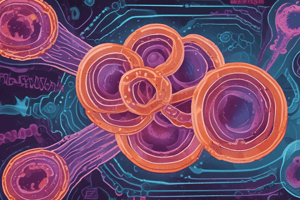Podcast
Questions and Answers
Which of the following is a major type of lung carcinoma?
Which of the following is a major type of lung carcinoma?
- Tuberculosis
- Bronchiolitis
- Pulmonary fibrosis
- Adenocarcinoma (correct)
What is the physiologic basis and use of pulmonary function tests?
What is the physiologic basis and use of pulmonary function tests?
- To measure the amount of air inhaled and exhaled (correct)
- To assess bronchial asthma manifestations
- To evaluate the histologic characteristics of lung carcinoma
- To diagnose tuberculosis infection
What are the clinical effects and complications of pneumothorax?
What are the clinical effects and complications of pneumothorax?
- Persistent cough and fever
- Chest pain and shortness of breath (correct)
- Hypertension and tachycardia
- Abnormal mucus production and wheezing
Which condition can cause fibrous thickening of alveolar septa?
Which condition can cause fibrous thickening of alveolar septa?
What type of lung injury can result from inhalation of injurious dust or particulate material?
What type of lung injury can result from inhalation of injurious dust or particulate material?
Which condition is associated with lung injury from inhalation of rock dust or asbestos fibers?
Which condition is associated with lung injury from inhalation of rock dust or asbestos fibers?
What can make lungs rigid and restrict normal respiratory excursions?
What can make lungs rigid and restrict normal respiratory excursions?
Which lung condition can also lead to cancer, specifically mesothelioma?
Which lung condition can also lead to cancer, specifically mesothelioma?
What are the key characteristics of tension pneumothorax?
What are the key characteristics of tension pneumothorax?
What are the common clinical features of pneumonia?
What are the common clinical features of pneumonia?
What characterizes Pneumocystis pneumonia?
What characterizes Pneumocystis pneumonia?
What is the functional unit of the lung for gas exchange?
What is the functional unit of the lung for gas exchange?
What causes inspiration, the process of air moving into the lungs?
What causes inspiration, the process of air moving into the lungs?
What is the site of oxygen and carbon dioxide exchange in the lungs?
What is the site of oxygen and carbon dioxide exchange in the lungs?
What is the characteristic feature of Usual Interstitial Pneumonia (UIP)?
What is the characteristic feature of Usual Interstitial Pneumonia (UIP)?
What is the main reason tuberculosis is difficult to destroy?
What is the main reason tuberculosis is difficult to destroy?
How is bronchiectasis diagnosed?
How is bronchiectasis diagnosed?
Which of the following is a characteristic of Chronic Obstructive Pulmonary Disease (COPD)?
Which of the following is a characteristic of Chronic Obstructive Pulmonary Disease (COPD)?
What is a key feature of Alpha1-Antitrypsin Deficiency in relation to emphysema development?
What is a key feature of Alpha1-Antitrypsin Deficiency in relation to emphysema development?
What is a characteristic feature of Neonatal Respiratory Distress Syndrome?
What is a characteristic feature of Neonatal Respiratory Distress Syndrome?
Study Notes
Respiratory Diseases Overview
- Pulmonary emphysema leads to destruction of alveolar structure and formation of large cystic spaces in the lungs, initially affecting upper lobes and eventually all lobes.
- Chronic Obstructive Pulmonary Disease (COPD) is caused by chronic irritation, mainly from smoking and inhalation of injurious agents.
- Three main anatomic derangements in COPD: inflammation and narrowing of terminal bronchioles, dilation and coalescence of pulmonary air spaces, and loss of lung elasticity.
- The pathogenesis of COPD involves chronic inflammatory swelling of mucosa, accumulation of leukocytes releasing proteolytic enzymes, and air trapping in the lungs.
- Management of COPD includes bronchodilators, inhaled steroids, oxygen therapy, lung therapy/exercise, and promoting drainage of bronchial secretions to decrease pulmonary infections.
- Lung damage caused by emphysema is irreversible and cannot be restored to normal.
- Alpha1-Antitrypsin Deficiency increases the risk of emphysema development, especially in cases of severe deficiency affecting lower lobes of the lungs.
- Bronchial Asthma involves spasmodic contraction of bronchial muscles, increased mucous secretions, and can be triggered by various stimuli.
- Treatment of Bronchial Asthma includes identifying and controlling triggers, using fast-acting and long-acting bronchodilators, and drugs that reduce airway reactivity.
- Neonatal Respiratory Distress Syndrome leads to progressive respiratory distress soon after birth, particularly in premature infants, infants delivered by cesarean section, and infants born to diabetic mothers.
- Adult Respiratory Distress Syndrome is characterized by shock, caused by damage to the alveolar membrane and fluid leakage, with a high mortality rate, especially in cases like COVID-19.
- Treatment of Adult Respiratory Distress Syndrome involves addressing the underlying condition, oxygen ventilation with slightly increased pressure, and has a high mortality rate.
Studying That Suits You
Use AI to generate personalized quizzes and flashcards to suit your learning preferences.
Related Documents
Description
Test your knowledge on the symptoms and diagnosis of Pneumocystis pneumonia, caused by the protozoan parasite Pneumocystis jiroveci. Learn about the thick mucous, non-productive cough, dyspnea, pulmonary consolidation, and diagnosis methods such as lung biopsy and bronchoscopy.




